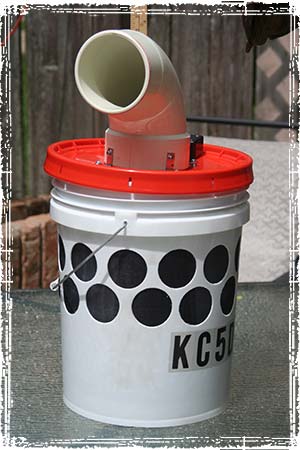 When I was much younger, I didn’t need a sleeping bag, mat, or even a tent when camping. We would take off for the wilderness with only an Indian blanket, a canteen of water, a Zippo lighter, or box of matches and have a great time. Since I’ve grown older, I’ve learned to appreciate the things I didn’t need back then.
When I was much younger, I didn’t need a sleeping bag, mat, or even a tent when camping. We would take off for the wilderness with only an Indian blanket, a canteen of water, a Zippo lighter, or box of matches and have a great time. Since I’ve grown older, I’ve learned to appreciate the things I didn’t need back then.
Temperatures in northwest Louisiana routinely reach the upper 90°s and low 100°s during the sunny days of summer. I’ve long been a fan of using solar energy to cook and power some of our phones and radios, so I decided to research and build a small evaporation cooler for camping, work, and around the house that will also run off solar power.
There are a lot of great articles and videos on the Internet showing several different styles of “bucket coolers.” After reading many articles and watching numerous videos on “Swamp Coolers” or “Bucket Coolers,” I settled on a design and began developing a parts list. It should be noted that I took advantage of the works others have done previously by using the same fan and pump observed because they have been proven effective in some of the videos and articles.
My parts list:
- 5-gallon plastic bucket with lid
- 4” 90° PVC
- 12 VDC water pump (Model 66039, from Harbor Freight)
- High-Speed Computer Case Fan
- SPST Switches (I purchased two from Radio Shack – your choice on which type you want to use)
- Project Box, small (Radio Shack)
- 1” L Brackets
- #6 screws, #6 flat washers, #6 lock washers, #6 nuts
- Filter material (minimum 24” X 36”)
- Window screen, black plastic (minimum 24” X 76”)
- Tubing (diameter to fit pump)
- T- fitting (diameter to fit tubing)
- Goop glue
- 4” dryer vent hose
- Cigarette lighter plug (male end)
Tools I used:
- Drill motor
- 2 – 2 1/8” hole saw
- Yardstick
- Razor knife
- Phillips head screwdriver
- Marker
- 5/32,” 3/16,” 15/32,” and ½,” drill bits
- Wire cutters
- Soldering iron
- Rosin Core Solder
- Tape Measure
- Electrical Tape
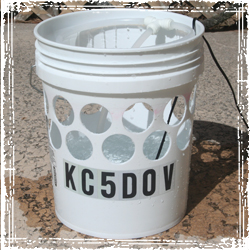 I began with a white 5-gallon bucket and lid from Home Depot. Two rows of 12 – 2 1/8” holes were drilled in the bucket, and the plastic burrs around each hole were removed. The holes are drilled around the top, leaving the bottom free for holding water.
I began with a white 5-gallon bucket and lid from Home Depot. Two rows of 12 – 2 1/8” holes were drilled in the bucket, and the plastic burrs around each hole were removed. The holes are drilled around the top, leaving the bottom free for holding water.
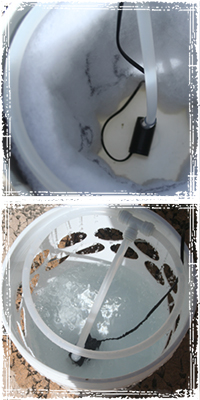 After drilling the 24 holes, a razor knife was used to de-bur the holes. Once all the holes were cleaned, a piece of window screen was cut to match the height and inside circumference of the bucket. The filter material was cut to the same dimensions. The pump was set in the bottom of the bucket and tubing cut to reach the top of the bucket.
After drilling the 24 holes, a razor knife was used to de-bur the holes. Once all the holes were cleaned, a piece of window screen was cut to match the height and inside circumference of the bucket. The filter material was cut to the same dimensions. The pump was set in the bottom of the bucket and tubing cut to reach the top of the bucket.
At the top, a T-connector was installed and a loop of tubing was measured and connected to the T. In the circle of tubing connected to the T, 3/32’ holes were drilled through the underside approximately every ¾” – 1” for water to flow down the filter. The screen and filter were removed, and approximately 2 ½ gallons of water were poured into the bucket, and the pump tested.
A hole, corresponding to inside diameter of the large end of the 90° PVC was cut into the lid. The fan was centered over the hole and connected to the lid with 4 – #6 screws, washers, and nuts. The 90° PVC was connected to the lid Using 4 – 1” L Brackets, screws, washers, lock washers, and nuts. A bead of GOOP put between the lid and PVC 90°, sealing it from any leakage of air. A dab of GOOP was also put on each screw and nut on the bottom of the lid to prevent them from loosening from the slight vibration of the pump and fan. On the lid of the plastic Project Box, two equally spaced and centered holes were drilled for the switches (I used 2 with on-off tags).
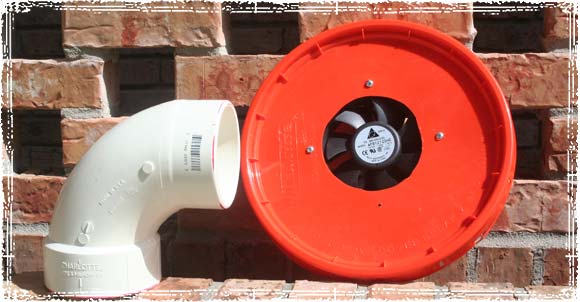
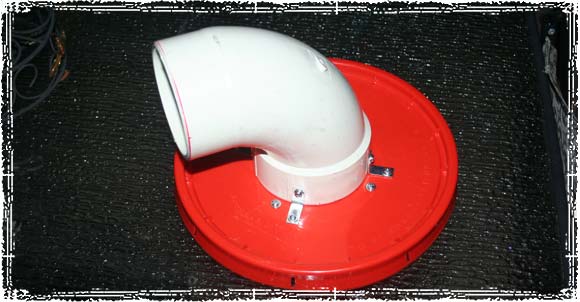
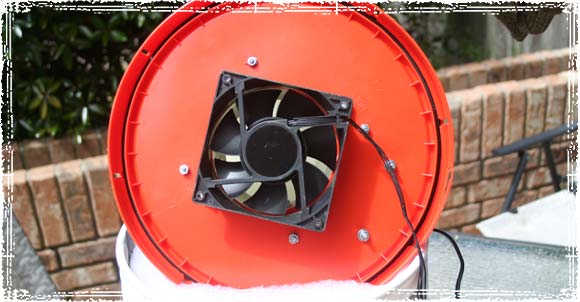 The switches were mounted to the top of the Project Box and then the Project Box was mounted to the lid behind the 90° PVC. A ½” hole was drilled through the box and lid. The pump and fan were wired to the switches with each connection being soldered. The power wires were connected to a longer wire with a fused cigarette lighter plug on the other end for use with our solar panels and deep cycle batteries.
The switches were mounted to the top of the Project Box and then the Project Box was mounted to the lid behind the 90° PVC. A ½” hole was drilled through the box and lid. The pump and fan were wired to the switches with each connection being soldered. The power wires were connected to a longer wire with a fused cigarette lighter plug on the other end for use with our solar panels and deep cycle batteries.
The cooler works great on hot days. It works better with lower humidity but still cools the air on humid days enough to be an asset when camping.
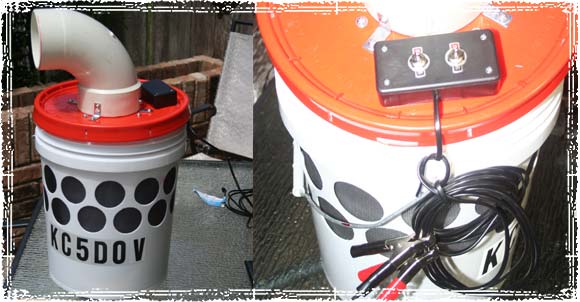
When camping, we run the cooler using a deep-cycle marine battery. A photovoltaic solar panel to charges the battery during the day. A standard dryer vent power cord installed hose directs or focuses the cooled air into our tent. If it gets too chilly in the tent a night, we can switch off the water flow and still have air circulation.
This particular set-up runs very quietly.
After running the fan and pump together it was observed that two (2) wraps of window screen are needed to keep water from running out the 24 holes as it drips down the filter material. Also, if used to cool a tent, the bucket cooler needs to be outside the tent, and there needs to be a vent or opening in the tent opposite from where the cooled air enters to prevent condensation from forming. A good point to remember is if you keep the deep cycle Marine battery connected to a solar charger or trickle charger, the water needs to be checked regularly to prevent a dry cell for forming.

I spent two or three nights reading, watching videos, thinking about how to make a cooler, and a little over three nights building and testing. Since the cooler will be used on a daily basis in the summer in my truck (for work), camping, and poolside, I decided to beef-up some areas. The 90° PVC fitting was connected with “L” brackets and sealed with GOOP glue ensuring now air leaks around the nozzle. All connections were soldered and taped with a quality electrical tape. The holes in the project box were sealed with the GOOP Glue. And don’t forget there are 24 – 2” or larger holes in the top of the bucket so it has lost a lot of structural strength and will not hold up much weight bearing down on the lid.
I also added 2 SPST switches to allow the pump to be turned on first, wetting the filter material. The other switch controls the fan. If it gets too chilly at night the pump can be shut off, leaving the fan on and the circulating air. The only change I foresee is changing the filter material to a more coarse material.
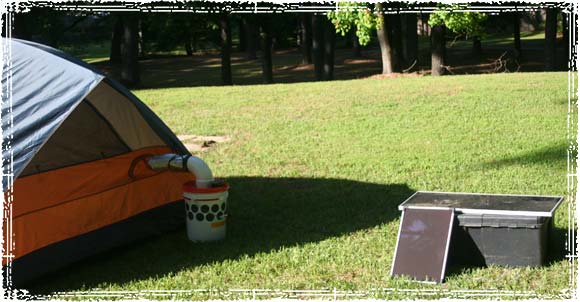
It’s not pure air conditioning, but it’s much better than just a fan blowing hot air, and we are more comfortable while we rough it.
Jim – KC5DOV
Note from OffGridSurvival: We would like to thank Jim for his extensive research and taking the time to provide this information for our readers.




I built the original design in 2010 for Burning Man.
There will be 5000 of these at the event this year.
Here’s the latest recap of all my designs.
They are all 12 volt DC.
https://eplaya.burningman.com/viewtopic.php?f=280&t=33842&start=2670
I read your works and watched your videos; they were excellent and gave me some good ideas and great info!
FIGJAM, you’ve made a lot of people much more comfortable with your ideas. Next spring, I’m building a larger cooler using a large Brute trashcan and a radiator fan for use poolside (if the fan isn’t too loud).
Thank you, Jim B. I reside in Florida. We have the solar power, but the humidity is through the roof. I was contemplating this design, but it will not be effective with our weather in the sunshine state. Great idea though if I go camping out of state! Thank you, everyone.
Can this be made for a room? The reason I ask is that I live in Western Montana, and during the summer the temps can get brutal (Even without the humidity), but I’d love to have something like this for at least my bedroom or computer room where the pc heats things up.
I’m looking at a minimum of $4,000 to 5,000 for ductless A/C and I’m 100% disabled which doesn’t make this an affordable option.
I’ve always wanted to start living off the grid because our power goes out during changes in weather.
Yes it will work for a room, but the key is to bring in dry air from outside, cool it and blow it into the room. You’ll also have to provide a way for the air to exit and be replaced by more cooled air by opening another window, etc.
If you draw inside air into the cooler all you’ll get is a hot, muggy room.
More even distribution of water from the loop might be accomplished by flipping the loop so the holes are on the top. That way the tube has to get full before dripping, and will, in theory, drip evenly all the way around.
tom
I’m going to try this next time we go out camping. I had not thought of turning the tube over and allowing it to fill first then flow out down the filter medium but think you’ve got a great idea with it – thanks!
Jim J. – KC5DOV
I turned the loop over as discussed above and as predicted TomW, the water flow was improved. I’m thinking of getting the next larger pump.
That creation is simply amazing! We have nothing to worry about our cooling dilemmas when we’re out of our house. Solar panels are definitely helpful and advantageous today, so it is really good to have one. Thanks for sharing this wonderful invention.
try digging a hole into the ground to get to the cool earth set the bucket down into the cool earth and put a towel around the bucket to keep the coolness in and run it like that the water will stay much cooler in the bucket will work wonderful thank you for your idea hope you will try very intercooler earth it works much better
Where did you find your filter pads. N5VGQ
I got the filter material from Lowe’s. However, I’m seriously contemplating changing to a more coarse filter medium next spring.
What do you mean by filtered materi
I’s the material the water drips down. It is A/C filter material minus the cardboard.
I have some charts on my “Our Bucket A/C unit (aka Swamp Cooler)” photo album on Facebook that shows the “minimum temperature possible due to evaporation.” Ours worked perfectly, although, in northwest Louisiana the humidity sometimes is sometimes too high for it to work 100% everyday but it helps keep the tent much more comfortable and allow better napping/sleeping and resting. However, you will have to send a friend request to see them.
Jim – KC5DOV
Facebook – https://www.facebook.com/KC5DOV
do you find it tedious having to remove the lid each time to top up the water? perhaps installing a simple toilet type ball valve, and connecting to a water supply would make keeping the bucket full of water much less laborious.
That would be great but we don’t have running water at our campsite. We have to pack our H2O in or use our filters with the creek water.
I use a piece of 3/4″ hose and a funnel to add water when we camp.
I saw plenty of trees try camping in the shade!!!
Rube Goldberg and McGiver would be amazed…..
Great job dude…..
Fantastic idea we live off grid in a fifth wheel and camp trailer. The gas bill for the generator is killing me, so the wife and kids can run the AC. I have a small solar set up so it can run fan and pump no problem during the day. In the process of building the house but might be a year before its done. Thanks for sharing I am sure this will work great
What do you think the issues would be if I were to scale this up to a large rubber trash can?
Will be following these directions for my hexayurt at Burning Man. What battery and solar panel did you use?
this design has been a Burning Man Tech staple for years! Combined with a foam panel HexiTurt and the ability to survive in high heat environments is excellent. If built with as a 12v system one can combine a briefcase solar panel recharger (under $50, Harbor Freight) and a deep cycle battery for long term extended use. Or dimply tie it to ones car system.
You can freeze a couple of two liter bottles and put them in there and have true air conditioning. It works!
Has anyone considered using a wicking material to draw water up into the surface that gets air drawn across it? This might eliminate the need for the pump altogether. If it worked it might also help with over saturating the material that causes dripping. I think you can buy polyester material used in diapers. Just a thought.
Anyway, love the design and I may play around with it. Thanks
FI
We made 3 while we were parked with some friends in the Quartzsite desert. They dont work great but they do work and relieve the heat.
If you add salt to your ice, it will get colder and stay frozen longer. Thanks so much for sharing this ingenius way to stay cooler!